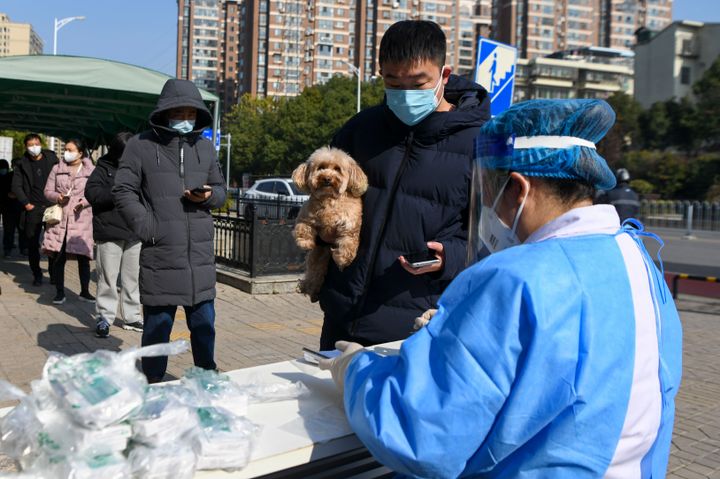Following a wave of anti-lockdown protests and confusing stats coming from Beijing’s government, the exponential rise in cases is alarming.
Here’s what you need to know.
What’s happening in China?
China has been criticised for being opaque over this current wave, but it’s pretty clear that case numbers are once again rising.
According to a leaked memo from a meeting of top health officials reported by the FT, Chinese authorities estimate that around 250 million people were infected with Covid in the first 20 days of December.
This adds up to around 18% of the population, as China has a population of 1.4 billion in total.
Of these cases, 37 million were thought to have caught the virus on Tuesday alone.
But this is far from the story told in the official data. It claims there were only 62,592 symptomatic Covid cases in the same time frame, during the first 20 days of December.
China has also only reported eight Covid-related deaths since December 1, despite the high tally of infections.
But, as the FT reported, crematoriums in Beijing can’t cope with the influx of bodies.
The infectious disease expert Professor Wang Guiqiang told a State Council news conference this week that Beijing had changed its guidelines around how to define a Covid-related death.
Now, only fatalities caused by pneumonia and respiratory failures in patients with Covid are considered, meaning it’s harder to understand how China compares to other countries.
According to the Guardian, he said: “Deaths caused by other diseases such as cardiovascular or cerebrovascular diseases and heart attacks are not classified as deaths caused by coronavirus.”
This goes against the World Health Organisation’s (WHO) advice, as “excess mortality” is usually a clearer measure of Covid’s reach. This is the difference between the number of deaths in a crisis and those under normal circumstances.
The rate of the infection is still rising too, although China has stopped trying to count the total number of infections by reducing testing – which, again, makes it hard to judge how many cases there really are across the country.
Why are cases rising?
China dropped its ‘zero-Covid’ policy earlier in December, after mass protests in major cities across the country.
As the only country in the world still pursuing restrictive Covid measures, the general public pushed back against Beijing, calling for more freedom once again.
Surprisingly, Beijing has (sort of) obliged and lifted some restrictions – now, it’s policy is ’living with Covid’, just as the virus has become too transmissible and is spreading rapidly.
There are still restrictions on travel within the country, but cases can isolate at home rather than at government centres, testing is voluntary and asymptomatic cases are no longer being considered.
But, the WHO also believes that it’s not the lifting of zero-Covid which has triggered the outbreak, but a lack of vaccinations. There is a low vaccine uptake rate across the country – only around 50% of China has received three shots.
Officials are trying to urge the elderly and vulnerable to receive the jab.
China’s zero-Covid policy did mean infections and deaths were low for much of the last two years than many other parts of the world, but that has shifted now that the zero-Covid policy has been dropped.
China has refused to vaccinate using the mrRna vaccines developed in Europe and the US, relying on its own vaccine instead, even though it less effective at preventing severe Omicron infections.
Some experts even believe 60% of the Chinese population will be infected in the next 90 days, which works out to 10% of the global population.
This is expected to have a significant knock-on effect for all health, as hospital staff prioritise Covid cases, as well as a longer term impact on the economy as a whole.
How are global authorities responding?
The World Health Organisation (WHO) has tried to encourage China to be clearer on how serious this breakout is.
It is calling for the Beijing government to share the case counts and hospitalisations.
The WHO said it was “very concerned” about the outbreak, and also called for an increase in the vaccine rollout, too.
The US’ secretary of state Atony Blinken has reportedly echoed such appeals, telling Chinese foreign minister Wang Yi about “the importance of transparency for the international community” when it came to Covid.
But, China’s National Health Commission is still not providing much clarity on what top health officials talked about on Wednesday.
China’s ministry of foreign affairs instead claimed on Friday that the spike in cases was ”on the whole predictable and under control”.
It said: “China has always shared its information responsibly with the WHO and the international community. We stand ready to work with the international community in solidarity.”
What do the experts think?
Head of public health laboratory sciences at the University of Hong Kong, Leo Poon, told the FT: “Of course, the virus is circulating in other regions as well...but the problem is other regions are actually doing sequencing and they share the data with global organisations.”
Even so, president of the Asia Pacific Society of Clinical Microbiology and Infection, Paul Tambyah, appeared to play down concerns.
He told Reuters: “I do not think that this is a threat to the world.
“The chances are that the virus will behave like every other human virus and adapt to the environment in which it circulates by becoming more transmissible and less virulent.”
However, Reuters also reported that prominent scientists and WHO advisers thought that the potentially lethal wave of infection could mean it was too early to declare an end to the global pandemic.


